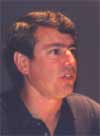Winter 2002
Interactive Game Totes Energy Costs
By Thomas W. Still
Associate Editor
Wisconsin State Journal

It began with a “What if?” question that seemed like a pipe dream and well beyond the capabilities of a bunch of low-tech journalists. “What if,” the partners in We the People/Wisconsin asked, “there was a computerized exercise to help citizens make choices about the kind of energy future they want?”
That blue-sky thinking became an innovative reality this fall, thanks to a partnership between We the People/ Wisconsin and the University of Wisconsin College of Engineering.
As part of its 2001 “Powering Wisconsin” project, which involved thousands of readers, listeners and viewers in a conversation about the state’s energy needs, We the People/ Wisconsin unveiled a computerized energy-choice simulator at a statewide citizens’ conference on Sept. 24.

The simulator is a hands-on, graphic tool to engage people in the choices they and public policymakers must make to ensure reliable, clean and affordable electricity supplies. Using data collected from public and private sources, the simulator showed citizens at the conference what it was like to make tough energy-policy choices.
The simulation estimates how much electricity Wisconsin will need to add over the next 15 years to keep up with rising demand and gives citizens a chance to decide, hypothetically, how much of each type of energy they would prefer to use.
Choices include power plants fueled by conventional coal, clean coal, natural gas or nuclear power, hydroelectric power, wind turbines, biomass plants or solar photovoltaic units (voltage that results when radiant energy falls on the boundary between two dissimilar substances). After recording your choices, the system calculates how much your electric bill will cost and how much pollution will be spewed into the air.
“We thought there were two things the public would take notice of – what it would do to electric bills and what it would do to greenhouse gas emissions,” said Gerald Kulcinski, College of Engineering associate dean for research.
Kulcinski, Paul Wilson, assistant professor of engineering and physics, and doctoral student Paul Meier developed the computer model with guidance from the media partners, who wanted an exercise that was sophisticated enough to be accurate – but easy enough for citizens with no particular energy expertise. The process began in May when the partners approached UW-Madison Chancellor John Wiley. Wiley, a physicist, asked the engineering college to get involved to demonstrate its commitment to the broader policy debate on energy in Wisconsin.
Four months later, more than 250 conference participants broke into seven groups to discuss which types of generation should be added and to find out what impact their changes would have.
For example, one group of about 35 people voted to replace about half of the state’s current coal-fired plants with cleaner coal technology, 1,000 megawatts each of natural gas-fired plants and wind turbines, as well as 3,500 megawatts of biomass plants, 200 megawatts of hydroelectric power and 100 megawatts of solar photovoltaic units.
The result: Sulfur dioxide emissions would be cut 21 percent but carbon dioxide pollution would increase 16 percent and nitrogen oxide would go up 7 percent. Electric bills would jump from the current $50 monthly to $103 monthly.
Participants learned that all energy sources come with pros and cons and even aggressive conservation strategies leave a gap between energy supplies and demand. Wisconsin’s demand for electrical energy climbed by 2.8 percent a year in the 1990s.
“There is no free lunch,” Kulcinski said. “People will find no matter what they do, their bill is going to go up.”
The conference included two exercises. The first assumed that Wisconsin’s energy demand through 2016 would mirror actual growth in the 1990s. The second allowed citizens to set their own demand numbers, which, in some groups, resulted in growth figures as low as 1 percent. Why? Citizens believed technology would spur energy conservation and efficiency.
A group of 30 middle-school students took part, joining the adult groups for the afternoon energy-choices exercise.
State utility spokesmen said the early simulator wasn’t perfect but they agreed it offered citizens a taste of the choices that must be made. “The first rule is: We’ve got to keep the lights on,” said Larry Salustro, senior vice president for Wisconsin Energy Corp. of Milwaukee.
“It’s a good model to teach the trade-offs that go into energy planning,” said Mark Williamson, executive vice president of Madison Gas & Electric Co.
Meier is refining and modifying the exercise for other discussions and for long-range planning by utilities and the government. It can be adapted for use in any state or community.
We the People/Wisconsin partners the Wisconsin State Journal, Wisconsin Public Television and Public Radio and Wood Communications Inc. in Madison.
